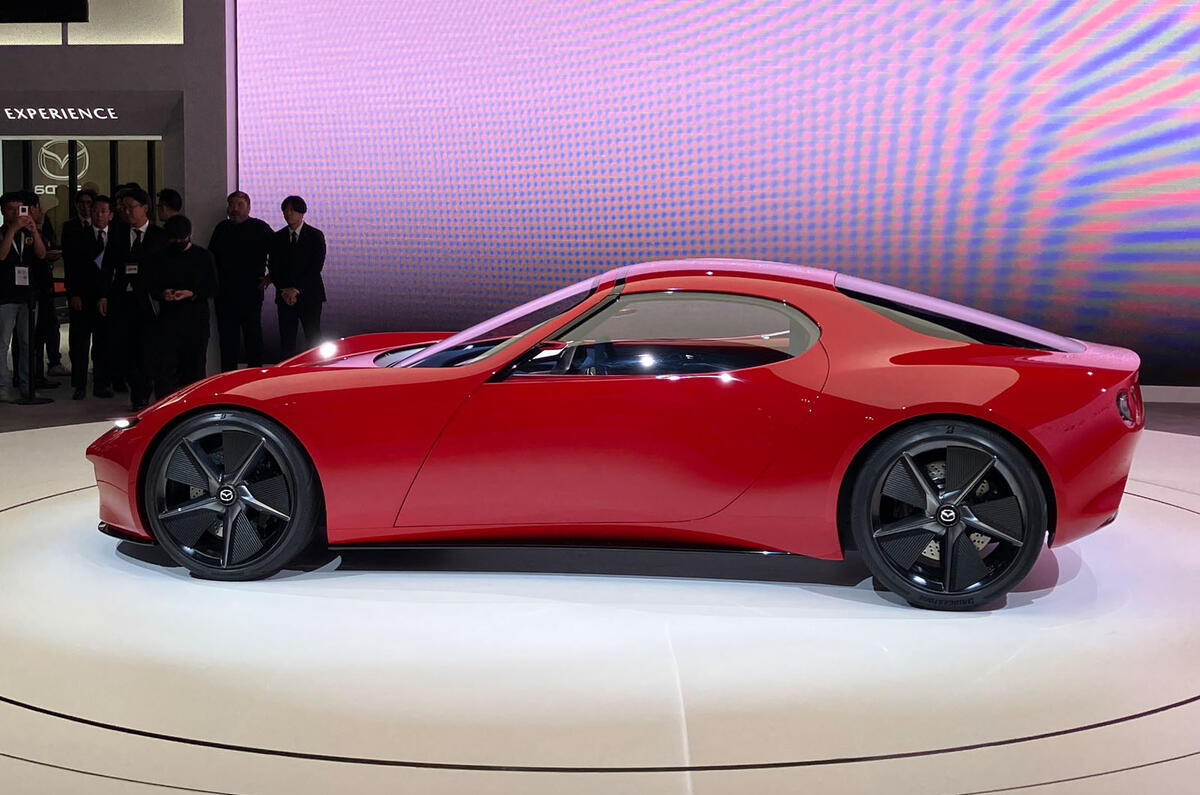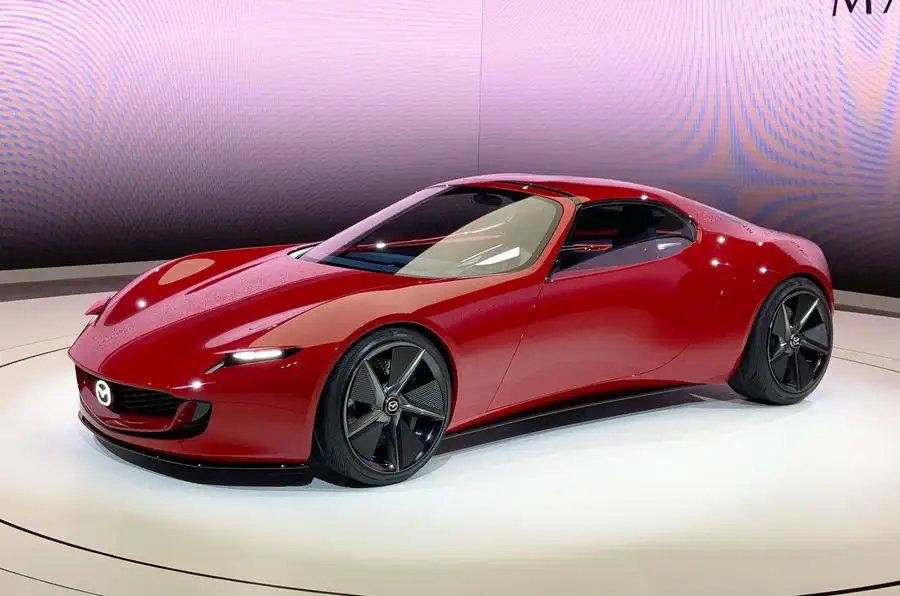Mazda has given a radical vision of the future for the venerable MX-5 by wowing the Tokyo motor show with a sleek, rotary-electric sports car concept called the Iconic SP.
The concept – previewed digitally a few months ago and presented as the centrepiece of a celebration of the MX-5 on Mazda’s Tokyo show stand – uses a rotary powertrain developed from that of the recently launched MX-30 R-EV crossover.
The Iconic SP uses a twin-rotor rotary engine (the MX-30’s is a single rotor) as a generator to charge a 17.8kWh battery on the move, rather than as an alternative means of driving the wheels itself.
Mazda claims the Iconic SP concept has 370bhp at its disposal – close to double that of the most powerful version of today's MX-5.
Tipping the scales at 1450kg – roughly on a par with the four-cylinder Lotus Emira, which produces 360bhp – the concept should be, theoretically, significantly faster than any road-going Mazda so far.
Mazda says a rotary range-extender powertrain makes sense for an electric sports car because it can be configured in a variety of layouts for optimum weight distribution and packaging. Here, for example, the tightly packaged petrol engine is housed in the middle of the car, which promotes a low centre of gravity while allowing for a long, probing front bonnet and cab-rear silhouette.
The two-seater concept measures 4180mm long, 1850mm wide and 1150mm tall, with a wheelbase of 2590mm, which makes it closer in size to the Alpine A110 than the MX-5.
The combination of the proportions, size, powertrain and packaging is what makes this “concept a demonstration to ourselves that what technologies we can put in a compact sports car” in the future, Mazda’s chief financial officer, Jeff Guyton, told Autocar. “We have packaging feasibility for things we’re talking about.
Guyton added: “By itself, the concept is not intended to be the next MX-5 or something else, although if the responses are great, that’s a nice indication that there could be some market for this.”
Mazda has given no indication of when an electrified MX-5 would make production, but now that the current car has been safeguarded against impending safety legislation, it can be expected to remain on sale until at least 2026.
The Iconic SP makes it clear that Mazda intends the MX-5 to live on in its future electrified line-up and the aim of this concept is as inspiration for a future MX-5, not a reborn RX, even though, like past RX sports cars, it uses a rotary engine.
Guyton said that while “there are technical solutions we have to make, especially with the emissions for the rotary, and with challenges left, including the battery packaging, some of the fundamentals are there.” He added: “This was a demonstration of ‘we want to put these pieces together, can we do it, make it compact and make it a sports car?’ We can.”
The packaging of the rotary “unlocks the concept’s unique proportions”, said Guyton, pointing out that it is based on a “unique” architecture for Mazda. While the concept is a hard-top coupé, it can be made into a convertible and that has been factored into its creation, said Guyton.
Mazda has long been vocal about the potential for combustion engines to survive into the future, running on synthetic fuels or hydrogen, rather than petrol or diesel, as a means of ensuring their carbon neutrality.
Mazda envisions that the Iconic SP's rotary engine would be able to run on "a variety of fuels, including hydrogen", and adds that "if the battery is charged with electricity derived from renewable energy, it is possible to drive in a virtually carbon-neutral state".
Guyton said that as a car maker selling in more than 130 countries, Mazda not only has a duty to produce decarbonised models but also to do so in a way that suited a majority of its markets – ie far from all markets are ready to go battery-electric – and it believes the Iconic SP’s powertrain solution delivers on that.
The cockpit give clues as to just how important handling is for this electric reimagining of the MX-5. The digital driver display hosts a g-meter and, intriguingly, a map of the Monaco Grand Prix circuit – hinting that the Vision SP has been conceived with rapid lap times and driver engagement as a prevailing focus.
There are shift paddles behind the steering wheel too for adjusting the brake regeneration and a touchscreen that looks to host controls for the active aerodynamic elements, suspension settings and launch control. Other visible features include a 360deg camera and an ultrasound sensor in the front grille, presumably for adaptive cruise control.
The cabin is trimmed in a blend of microsuede and Mazda's plant-based bio-fabric material in a nod to the firm's ambitious pledge to be completely carbon neutral by 2050.
Recently appointed Mazda CEO Masahiro Moro, revealing the concept in Tokyo, said: "We love the MX-5, and the world loves the MX-5. We are determined in the age of electrification to keep the joy of driving which the MX-5 represents alive and the Mazda Iconic SP, with its dual rotary power generator-EV powertrain is our dream solution – a dream we will work hard to launch.
“Mazda will always deliver vehicles that remind people that cars are pure joy and an indispensable part of their lives.”
He was named as Mazda's new CEO in March of this year, at the same time as the company announced a massive £8.7 billion electrification initiative, under which it will introduce new hybrid and pure-electric models by 2027, before working to electrify all of its cars from 2028.


![]()
![]()



